初中七年级上册英语: StarterUnit1教案
- 格式:doc
- 大小:51.07 KB
- 文档页数:11
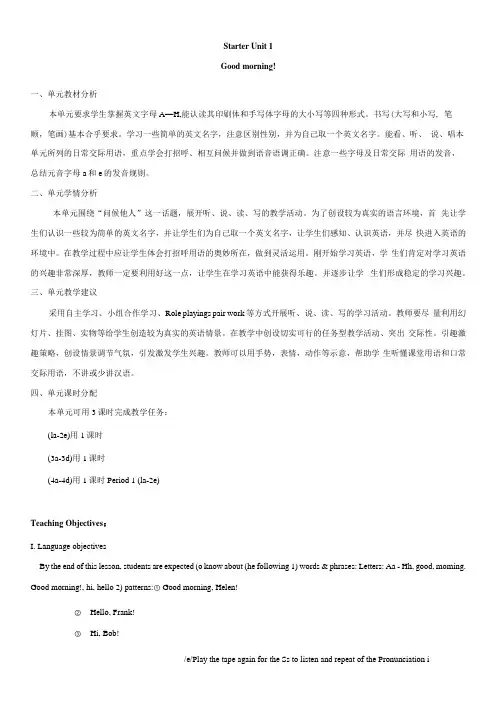
Starter Unit 1Good morning!一、单元教材分析本单元要求学生掌握英文字母A—H,能认读其印刷体和手写体字母的大小写等四种形式。
书写(大写和小写, 笔顺,笔画)基本合乎要求。
学习一些简单的英文名字,注意区别性别,并为自己取一个英文名字。
能看、听、说、唱本单元所列的日常交际用语,重点学会打招呼、相互问候并做到语音语调正确。
注意一些字母及日常交际用语的发音,总结元音字母a和e的发音规则。
二、单元学情分析本单元围绕“问候他人”这一话题,展开听、说、读、写的教学活动。
为了创设较为真实的语言环境,首先让学生们认识一些较为简单的英文名字,并让学生们为自己取一个英文名字,让学生们感知、认识英语,并尽快进入英语的环境中。
在教学过程中应让学生体会打招呼用语的奥妙所在,做到灵活运用。
刚开始学习英语,学生们肯定对学习英语的兴趣非常深厚,教师一定要利用好这一点,让学生在学习英语中能获得乐趣。
并逐步让学生们形成稳定的学习兴趣。
三、单元教学建议采用自主学习、小组合作学习、Role playings pair work等方式开展听、说、读、写的学习活动。
教师要尽量利用幻灯片、挂图、实物等给学生创造较为真实的英语情景。
在教学中创设切实可行的任务型教学活动、突出交际性。
引趣激趣策略,创设情景调节气氛,引发激发学生兴趣。
教师可以用手势,表情,动作等示意,帮助学生听懂课堂用语和口常交际用语,不讲或少讲汉语。
四、单元课时分配本单元可用3课时完成教学任务:(la-2e)用1课时(3a-3d)用1课时(4a-4d)用1课时Period 1 (la-2e)Teaching Objectives:I. Language objectivesBy the end of this lesson, students are expected (o know about (he following 1) words & phrases: Letters: Aa - Hh, good, moming. Good morning!, hi, hello 2) patterns:① Good morning, Helen!②Hello, Frank!③Hi, Bob!/e/Play the tape again for the Ss to listen and repeat of the Pronunciation iStep III PracticeNow let's work on 4c. First, let's read the words and letters in column 1.(Ss read the he words and letters in column 1 aloud.)Look at the words in column 2. Can you read them out?(提醒学生右栏中的单词中黑体字母的发音与左栏中的读音一样。
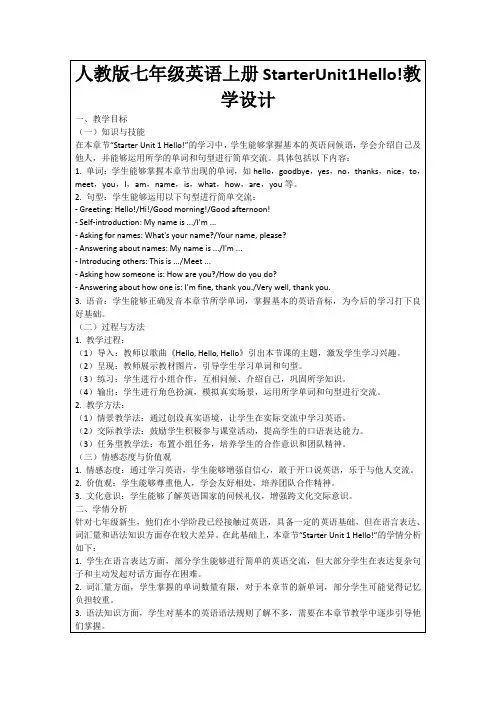
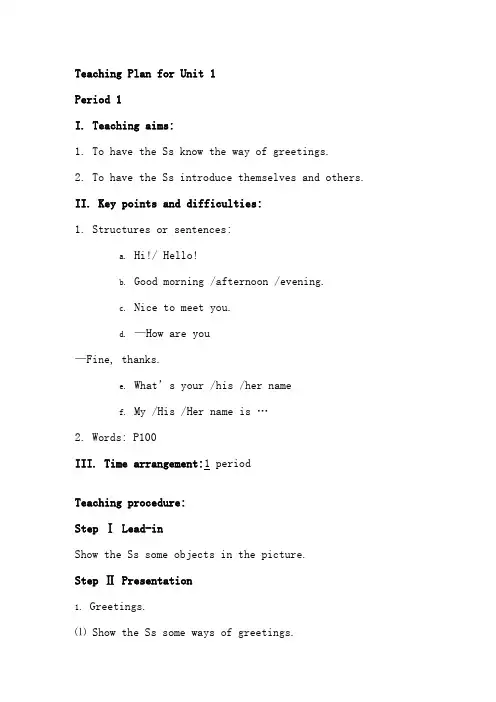
Teaching Plan for Unit 1Period 1I. Teaching aims:1. To have the Ss know the way of greetings.2. To have the Ss introduce themselves and others. II. Key points and difficulties:1. Structures or sentences:a.Hi!/ Hello!b.Good morning /afternoon /evening.c.Nice to meet you.d.—How are you—Fine, thanks.e.What’s your /his /her namef.My /His /Her name is …2. Words: P100III. Time arrangement:1 periodTeaching procedure:Step Ⅰ Lead-inShow the Ss some objects in the picture.Step Ⅱ Presentation1.Greetings.⑴ Show the Ss some ways of greetings.⑵ Ask the Ss to match the greeting sentences with the correct answer sentences.⑶ Watch a video.2. Introduce self.⑴ Question: How to introduce yourself and others(Ask some Ss to try to answer it.)New structures and sentences.T: Just now I asked you how to introduce yourself and ask others’ names. Now please listen to me carefully. (Show the Ss some sample dialogues.)eg.1 A: What’s your nameB: My name is Gina. / I’m Gina.⑵ 1b Listen and number the conversations.(3) Chain work(4) Point to the photos of famous people and ask the Ss to make dialogues.eg.2 A: What’s his/her nameB: His/Her name is Gina./He/She is Gina.3. 2a Number the pictures.4. 2b ListeningStep Ⅲ PracticeGroup work: Making new friends用下面的对话, 介绍新朋友。
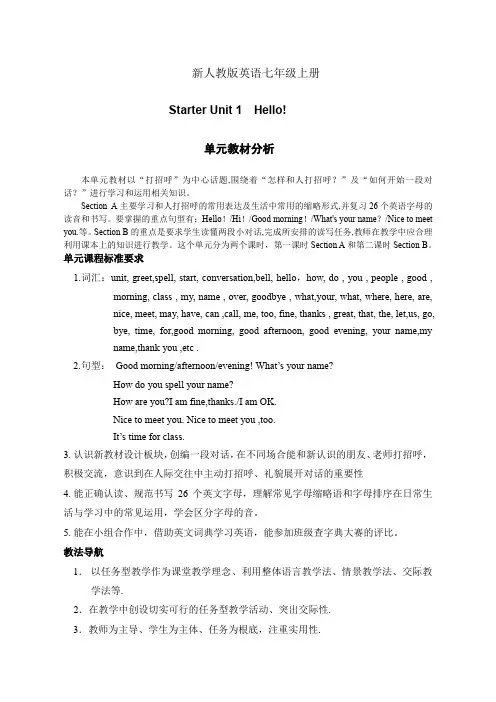
新人教版英语七年级上册Starter Unit 1Hello!单元教材分析本单元教材以“打招呼”为中心话题,围绕着“怎样和人打招呼?”及“如何开始一段对话?”进行学习和运用相关知识。
Section A主要学习和人打招呼的常用表达及生活中常用的缩略形式,并复习26个英语字母的读音和书写。
要掌握的重点句型有:Hello!/Hi!/Good morning!/What's your name?/Nice to meet you.等。
Section B的重点是要求学生读懂两段小对话,完成所安排的读写任务,教师在教学中应合理利用课本上的知识进行教学。
这个单元分为两个课时,第一课时Section A和第二课时Section B。
单元课程标准要求1.词汇:unit, greet,spell, start, conversation,bell, hello,how, do , you , people , good ,morning, class , my, name , over, goodbye , what,your, what, where, here, are,nice, meet, may, have, can ,call, me, too, fine, thanks , great, that, the, let,us, go,bye, time, for,good morning, good afternoon, good evening, your name,myname,thank you ,etc .2.句型:Good morning/afternoon/evening! What’s your name?How do you spell your name?How are you?I am fine,thanks./I am OK.Nice to meet you. Nice to meet you ,too.It’s time for class.3.认识新教材设计板块,创编一段对话,在不同场合能和新认识的朋友、老师打招呼,积极交流,意识到在人际交往中主动打招呼、礼貌展开对话的重要性4.能正确认读、规范书写26个英文字母,理解常见字母缩略语和字母排序在日常生活与学习中的常见运用,学会区分字母的音。
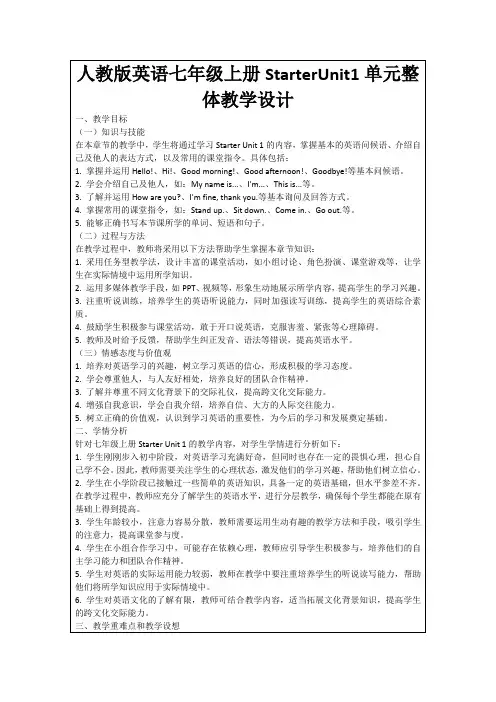
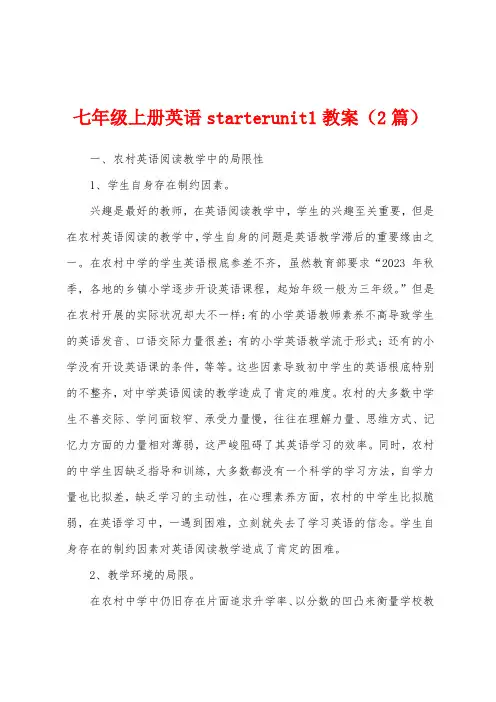
七年级上册英语starterunit1教案(2篇)一、农村英语阅读教学中的局限性1、学生自身存在制约因素。
兴趣是最好的教师,在英语阅读教学中,学生的兴趣至关重要,但是在农村英语阅读的教学中,学生自身的问题是英语教学滞后的重要缘由之一。
在农村中学的学生英语根底参差不齐,虽然教育部要求“2023年秋季,各地的乡镇小学逐步开设英语课程,起始年级一般为三年级。
”但是在农村开展的实际状况却大不一样:有的小学英语教师素养不高导致学生的英语发音、口语交际力量很差;有的小学英语教学流于形式;还有的小学没有开设英语课的条件,等等。
这些因素导致初中学生的英语根底特别的不整齐,对中学英语阅读的教学造成了肯定的难度。
农村的大多数中学生不善交际、学问面较窄、承受力量慢,往往在理解力量、思维方式、记忆力方面的力量相对薄弱,这严峻阻碍了其英语学习的效率。
同时,农村的中学生因缺乏指导和训练,大多数都没有一个科学的学习方法,自学力量也比拟差,缺乏学习的主动性,在心理素养方面,农村的中学生比拟脆弱,在英语学习中,一遇到困难,立刻就失去了学习英语的信念。
学生自身存在的制约因素对英语阅读教学造成了肯定的困难。
2、教学环境的局限。
在农村中学中仍旧存在片面追求升学率、以分数的凹凸来衡量学校教学工作的现象,为了抓升学率,分好班差班,这种卑视性的教学安排极简单打击学生学习的热忱。
在农村的学校中,教学设备相对落后,市内学校中常见的多媒体教学设备在农村的学校中是很难见到的,在教学帮助工具上的配备也不是很齐全,学校的图书室中根本没有适合中学生阅读的英文报刊、杂志,课堂教学不丰富,课外延长阅读根本没有,这种状况不利于开阔学生的视野,学生对英语的阅读兴趣会大大降低。
3、教师队伍数量缺乏、质量不高。
在英语教学中,教师是关键性的角色,教师素养的凹凸直接影响教学效果和教学水平,依据最新的数据显示,我国目前的初中英语教师学历的达标率为90.38%,这也就意味着在农村的中学中还是有一局部教师的学历没有达标,这在很大程度上限制了农村中学英语教学质量的提高。
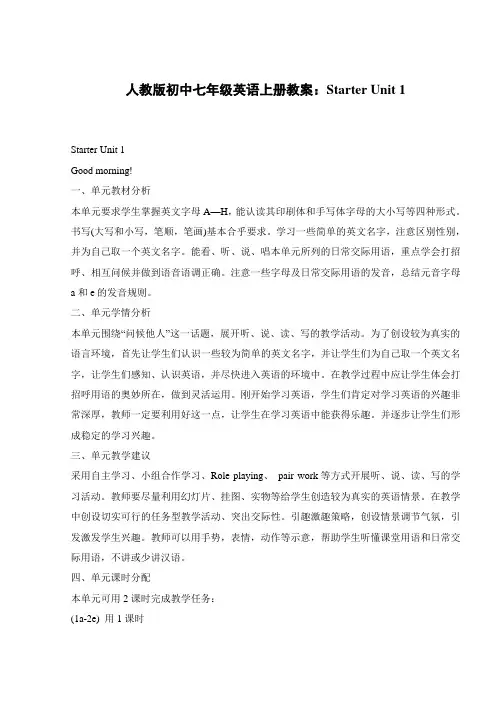
人教版初中七年级英语上册教案:Starter Unit 1Starter Unit 1Good morning!一、单元教材分析本单元要求学生掌握英文字母A—H,能认读其印刷体和手写体字母的大小写等四种形式。
书写(大写和小写,笔顺,笔画)基本合乎要求。
学习一些简单的英文名字,注意区别性别,并为自己取一个英文名字。
能看、听、说、唱本单元所列的日常交际用语,重点学会打招呼、相互问候并做到语音语调正确。
注意一些字母及日常交际用语的发音,总结元音字母a和e的发音规则。
二、单元学情分析本单元围绕“问候他人”这一话题,展开听、说、读、写的教学活动。
为了创设较为真实的语言环境,首先让学生们认识一些较为简单的英文名字,并让学生们为自己取一个英文名字,让学生们感知、认识英语,并尽快进入英语的环境中。
在教学过程中应让学生体会打招呼用语的奥妙所在,做到灵活运用。
刚开始学习英语,学生们肯定对学习英语的兴趣非常深厚,教师一定要利用好这一点,让学生在学习英语中能获得乐趣。
并逐步让学生们形成稳定的学习兴趣。
三、单元教学建议采用自主学习、小组合作学习、Role playing、pair work等方式开展听、说、读、写的学习活动。
教师要尽量利用幻灯片、挂图、实物等给学生创造较为真实的英语情景。
在教学中创设切实可行的任务型教学活动、突出交际性。
引趣激趣策略,创设情景调节气氛,引发激发学生兴趣。
教师可以用手势,表情,动作等示意,帮助学生听懂课堂用语和日常交际用语,不讲或少讲汉语。
四、单元课时分配本单元可用2课时完成教学任务:(1a-2e) 用1课时(3a-4d) 用1课时(1a-2d)一、教学目标:1. 语言知识目标:1) 能掌握以下词汇:字母Aa ~ Hh, good, morning, Good morning!, hi, hello2) 能掌握以下句型:①Good morning, Helen!②Hello, Frank!③Hi, Bob!3) 能理解用英语打招呼的不同说法,并能灵活运用。
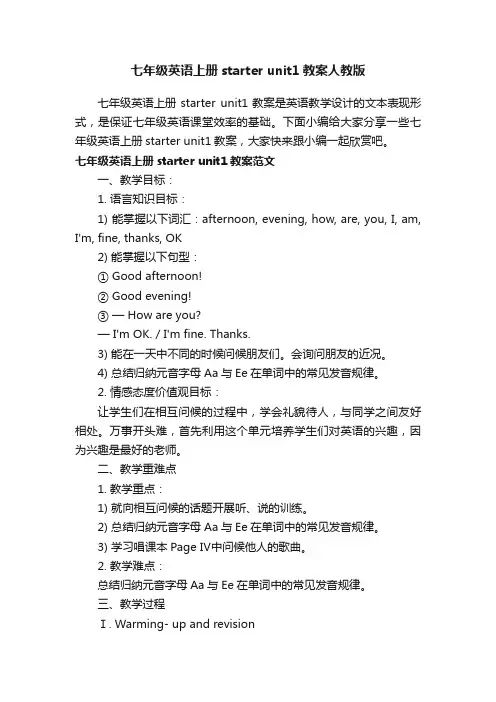
七年级英语上册starter unit1教案人教版七年级英语上册starter unit1教案是英语教学设计的文本表现形式,是保证七年级英语课堂效率的基础。
下面小编给大家分享一些七年级英语上册starter unit1教案,大家快来跟小编一起欣赏吧。
七年级英语上册starter unit1教案范文一、教学目标:1. 语言知识目标:1) 能掌握以下词汇:afternoon, evening, how, are, you, I, am, I'm, fine, thanks, OK2) 能掌握以下句型:① Good afternoon!② Good evening!③ — How are you?— I'm OK. / I'm fine. Thanks.3) 能在一天中不同的时候问候朋友们。
会询问朋友的近况。
4) 总结归纳元音字母Aa与Ee在单词中的常见发音规律。
2. 情感态度价值观目标:让学生们在相互问候的过程中,学会礼貌待人,与同学之间友好相处。
万事开头难,首先利用这个单元培养学生们对英语的兴趣,因为兴趣是最好的老师。
二、教学重难点1. 教学重点:1) 就向相互问候的话题开展听、说的训练。
2) 总结归纳元音字母Aa与Ee在单词中的常见发音规律。
3) 学习唱课本Page Ⅳ中问候他人的歌曲。
2. 教学难点:总结归纳元音字母Aa与Ee在单词中的常见发音规律。
三、教学过程Ⅰ. Warming- up and revision1. Greet the Ss.T: Good morning, Class!Ss: Good morning, Mr./Ms. …(Say it again several times.) Then sing the "Good morning!" song.Now greet your partner with your English names.S1: Good morning, Dale!S2: Hello, Frank!S3: Good morning, Eric!S4: Hi, Grace!…2. Now let's review the English letters Aa ~Hh. Who can recite them?S1: A, B, C, D, …S2: A, B, C, D, …3. Can you write them?Please write the letters on a piece of paper then check with your partner.Ask some Ss come to the Bb and write them on the Bb.(注意和同学们一起纠正个别同学不正确的笔顺。
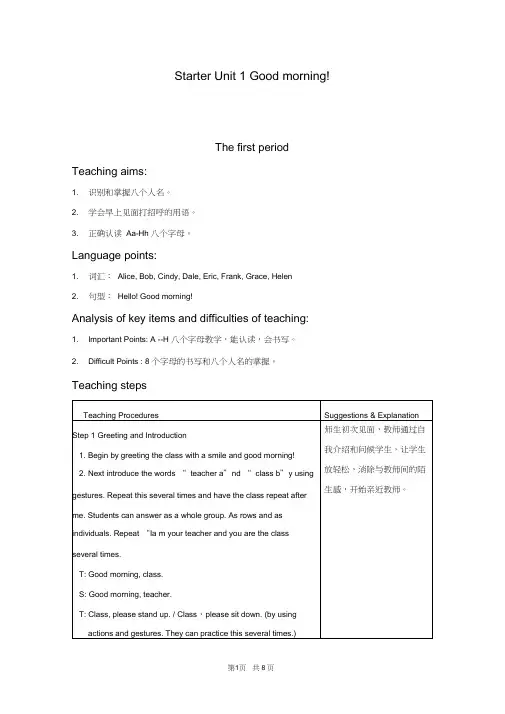
Starter Unit 1 Good morning!The first period Teaching aims:1. 识别和掌握八个人名。
2. 学会早上见面打招呼的用语。
3. 正确认读Aa-Hh 八个字母。
Language points:1. 词汇:Alice, Bob, Cindy, Dale, Eric, Frank, Grace, Helen2. 句型:Hello! Good morning!Analysis of key items and difficulties of teaching:1. Important Points: A --H 八个字母教学,能认读,会书写。
2. Difficult Points : 8 个字母的书写和八个人名的掌握。
Teaching stepsTeaching aims:1. 学会正确朗读和书写Aa-Hh 八个字母。
2. 了解一些常用缩略字的含义。
3. 巩固所学的八个人名。
4. 有英文名字的记住自己和同伴的英文名字Language points:词汇:自己和同伴的英文名字。
Analysis of key items and difficulties of teaching:1. Important Points: 学会简单的问候用语。
2. Difficult Points: 八个字母的正确书写和记住尽可能多的名字。
Teaching stepsThe third periodTeaching aims:1. 学会不同时段打招呼的用语。
2. 学习熟识朋友见面的问候语和应答。
3. 记住尽可能多的同学的名字。
Language points:句型:Good afternoon! Good evening!--How are you? --I 'm fine, thanks.--How are you? --I 'm OK.Analysis of key items and difficulties of teaching:1. Important Points: 掌握元音字母 A 和 E 在单词中的发音.2. Difficult Points: 用英文名字来跟朋友打招呼问候。
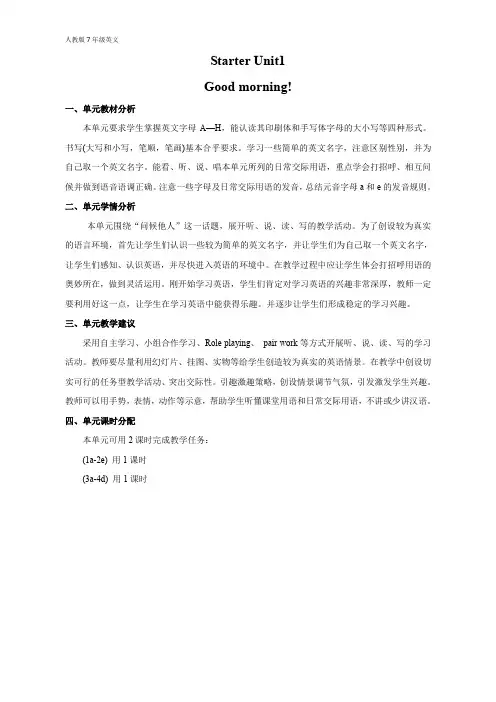
Starter Unit1Good morning!一、单元教材分析本单元要求学生掌握英文字母A—H,能认读其印刷体和手写体字母的大小写等四种形式。
书写(大写和小写,笔顺,笔画)基本合乎要求。
学习一些简单的英文名字,注意区别性别,并为自己取一个英文名字。
能看、听、说、唱本单元所列的日常交际用语,重点学会打招呼、相互问候并做到语音语调正确。
注意一些字母及日常交际用语的发音,总结元音字母a和e的发音规则。
二、单元学情分析本单元围绕“问候他人”这一话题,展开听、说、读、写的教学活动。
为了创设较为真实的语言环境,首先让学生们认识一些较为简单的英文名字,并让学生们为自己取一个英文名字,让学生们感知、认识英语,并尽快进入英语的环境中。
在教学过程中应让学生体会打招呼用语的奥妙所在,做到灵活运用。
刚开始学习英语,学生们肯定对学习英语的兴趣非常深厚,教师一定要利用好这一点,让学生在学习英语中能获得乐趣。
并逐步让学生们形成稳定的学习兴趣。
三、单元教学建议采用自主学习、小组合作学习、Role playing、pair work等方式开展听、说、读、写的学习活动。
教师要尽量利用幻灯片、挂图、实物等给学生创造较为真实的英语情景。
在教学中创设切实可行的任务型教学活动、突出交际性。
引趣激趣策略,创设情景调节气氛,引发激发学生兴趣。
教师可以用手势,表情,动作等示意,帮助学生听懂课堂用语和日常交际用语,不讲或少讲汉语。
四、单元课时分配本单元可用2课时完成教学任务:(1a-2e) 用1课时(3a-4d) 用1课时(1a-2d)一、教学目标:1. 语言知识目标:1) 能掌握以下词汇:字母Aa ~ Hh, good, morning, Good morning!, hi, hello2) 能掌握以下句型:①Good morning, Helen!②Hello, Frank!③Hi, Bob!3) 能理解用英语打招呼的不同说法,并能灵活运用。
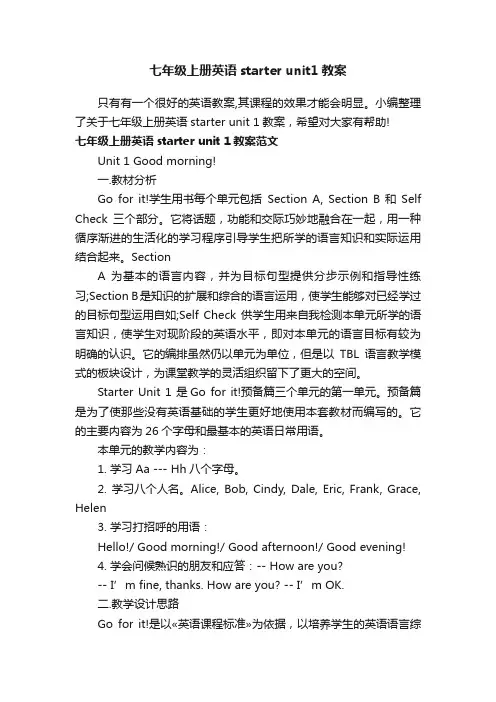
七年级上册英语starter unit1教案只有有一个很好的英语教案,其课程的效果才能会明显。
小编整理了关于七年级上册英语starter unit 1教案,希望对大家有帮助!七年级上册英语starter unit 1教案范文Unit 1 Good morning!一.教材分析Go for it!学生用书每个单元包括Section A, Section B 和Self Check三个部分。
它将话题,功能和交际巧妙地融合在一起,用一种循序渐进的生活化的学习程序引导学生把所学的语言知识和实际运用结合起来。
SectionA 为基本的语言内容,并为目标句型提供分步示例和指导性练习;Section B是知识的扩展和综合的语言运用,使学生能够对已经学过的目标句型运用自如;Self Check 供学生用来自我检测本单元所学的语言知识,使学生对现阶段的英语水平,即对本单元的语言目标有较为明确的认识。
它的编排虽然仍以单元为单位,但是以TBL语言教学模式的板块设计,为课堂教学的灵活组织留下了更大的空间。
Starter Unit 1 是Go for it!预备篇三个单元的第一单元。
预备篇是为了使那些没有英语基础的学生更好地使用本套教材而编写的。
它的主要内容为26个字母和最基本的英语日常用语。
本单元的教学内容为:1. 学习Aa --- Hh八个字母。
2. 学习八个人名。
Alice, Bob, Cindy, Dale, Eric, Frank, Grace, Helen3. 学习打招呼的用语:Hello!/ Good morning!/ Good afternoon!/ Good evening!4. 学会问候熟识的朋友和应答:-- How are you?-- I’m fine, thanks. How are you? -- I’m OK.二.教学设计思路Go for it!是以«英语课程标准»为依据,以培养学生的英语语言综合运用能力为目标,每个单元的教学内容都围绕一个话题,让学生在完成各项任务的过程中学会语言,真正体现:“Learn by doing. Learn by using.‖ 这一教学原则。
课时备课主问题1设计意图(主要从“知识重点难点”与“学科核心素养”两个角度分析)此设计是让学生初步认识课文中的人物,了解他们的名字和性别,为下一步的学习奠定基础。
主问题1预设答案:Boy’s nameBob Dale Eric FrankGirl’s nameGrace Cindy Alice Helen学习活动二主问题2. 你知道怎么用英语进行简单的问候吗?学法指导:第一步:自学探究——“学法指导”设计(自学要求)(1)看课本s1,请写出每组对话的答语。
A: Good morning!B:A: Good afternoon!B:A: Good evening!B:A: Hi! B:A: Hello! B:(2)Listen and repeat.(1b)第二步:互学讨论——“学法指导”设计(互学要求)Division of team leaders.Practice with your partners .根据如下时间一起完成互相问候。
第三步:展学交互——“学法指导”设计(展学要求)(1)The display students should answer fluently and loudly.(展示同学语言流畅、声音洪亮。
)(2)Other groups listen carefully,ask questions and make ments.(其他小组认真倾听、积极补充、质疑评价。
)主问题2设计意图(主要从“知识重点难点”与“学科核心素养”两个角度分析)此步骤的设计是让学生接触到地道的英语,先听后说,练习正确的语音语调,养成学习英语的良好习惯。
并鼓励学生尽可能用自己刚才得到的英语名字进行操练,也允许他们使用自己的中文名字进行练习,其目的是鼓励学生大胆开口,开始养成愿意说的良好习惯。
主问题2预设答案:Good morning.Good afternoon.Good evening.Hi! Hello!学习活动三主任务3. 当堂练习(当堂检测)学法指导:第一步:自学探究——“学法指导”设计(自学要求)Do the exercises by yourselves.第二步:互学讨论——“学法指导”设计(互学要求)Division of team leaders.Discuss the answers in your group.第三步:展学交互——“学法指导”设计(展学要求)(1)The display students should answer fluently and loudly.(展示同学语言流畅、声音洪亮。
人教版初中七年级英语上册教案:Starter Unit 1教学目标:•学习并掌握数字0-10的英文表达。
•学会用英语问候和作自我介绍。
•培养学生的口语能力,提高听、说能力。
教学内容:•数字0-10的英文表达。
•打招呼、问候、道别、自我介绍等口语表达。
•让学生听、说、读、写数字和简单句。
教学重点:•数字0-10的英文表达。
•打招呼、问候、道别、自我介绍等口语表达。
教学难点:•数字6-10的读音和写法。
教学准备:•课件•展示板教学过程:一、导入1.Greeting 问候教学生,并简单介绍课程安排。
2.Show Time 展示数字0-10的图片,让学生根据图片快速说出数字。
在展示过程中,强调数字的重要性并鼓励学生发出自己的声音。
二、学习数字表达1.讲解数字表达的读音和写法,并在展示板上示范如何写出数字和发音。
让学生跟随读出每个数字,并在展示板上写下数字。
2.练习时间:让学生说出0-10的数字,并在展示板上写出来。
教师看着学生的写法指出学生的错误,并给予正确的写法和读音指引。
三、学习问候和自我介绍1.让学生听并模仿教师的问候语言和自我介绍语言,让学生知道如何在英语中问候别人和自我介绍。
2.练习时间:两两合作,互相进行问候和自我介绍,并记录好对方的名字和数字。
四、总结1.教师总结数字0-10和问候语言的学习内容,并让一个学生复述一下学习的重点。
如果有学生遗漏了重点内容,可以再让其他学生帮助提醒。
2.下个学习目标预告:学习英语中的语音、语调和读音。
课后作业:1.练习数字0-10的写法和读音。
2.和家人或朋友练习问候和自我介绍,并记下对方的名字和数字。
教学反馈:•通过学生的回答和表现来判断教学效果,进而为后续教学做出调整和改善。
人教新目标英语七年级上册Starter Unit 1 Good morning!一、课程目标1、知识和能力目标:a)本单元要求学生掌握英文字母A—H,能认读这八个字母的大小写形式;b)书写(大写和小写,笔顺,笔画)基本合乎要求;c)能看,听,说本单元所列的日常交际用语,重点学会打招呼,并做到语音语调正确;d)注意一些字母及日常交际用语的发音,提醒学生不要将C/si:/发成/sei:/;H /eiʧ/发成/eʧ/等。
2、过程和方法目标:教师要尽量用英语组织教学。
充分利用课堂的45分钟,少讲汉语,尽量给学生创造英语情景。
教师可以用手势,表情,动作等示意,帮助学生听懂课堂用语和日常交际用语,第一次介绍某个用语时,说英语,加译文及手势,以后可酌情省去译文,最后只说英语,逐步让学生听懂。
3、情感态度和价值观目标:万事开头难,首先利用这个单元培养学生们对英语的兴趣,因为兴趣是最好的老师。
二、重点、难点a)听说读写字母A-Hb)学会如何与人打招呼,并识记Good morning、Good afternoon、Good evening、Good night等句子。
三、学情分析由于我校是一个农村大校,农村英语教师缺乏,小学阶段的大部分英语课程都是自习或者非专业老师上课,造成学生英语基础普遍薄弱,学习兴趣不高。
但是七年级学生刚由小学升入初中,思想比较单纯,听话,故可塑性很高。
针对此问题,我会着眼于学生兴趣,放慢学习速度,从ABC字母重新带领学生进入英语学习世界。
本单元将按以下四个课时进行授课:Period 1Step 1:IntroductionBegin by greeting the class with a smile and good morning!Now,introduce the words “teacher” and “class”.by using gestures.Repeatthis several times and have the class repeat after you.Students can answer as awhole group.As rows and as individuals.Repeat “I am your teacher and youa re the class” several times.Now,introduce the class to the instructions:Class,please sit down and class,please stand up by using actions and gestures.They can practice this severaltimes.Step 2:Lead—inYou may want to leave the class again to introduce the usual Good morningroutine.Say Good morning class.Help students respond with Goodmorning.Point to yourself and say I’m Ms.…Have them repeat.Repeat this a few times with rows and individuals or try a “back-chain” drill:Miss,Mr.… (Ss repeat)Morning,Miss/M r.… (S s repeat)Good morning,Miss,Mr.… (Ss repeat)Step 3:PracticeSay:Stand up,please! (Ss stand up)Leave the classroom,return and say Good morning,class! Help the studentsrespond with Good morning,Miss/,Mr.…Say Sit down,please.Now let’sstart the lesson.Step 4:Presentation and activityNow point to yourself and say My name is Miss/Mr. … I am your teacher.Find a student you know and say your name is…(Sarah).Then ask What isyour name? Help them respond with My name is…. When the studentanswers, respond with Hel lo…Nice to meet you! Repeat this activity severaltimes,first with students you know and then with others.Help them torespond with Nice to meet you,too.Explain the Word “too’’ in Chinese.Step 5:PracticeGet the students to practice the following dialogue in pairs.S1:Good morning.S2:Good morning.I’m (Sarah).What’s your name?Sl:My name is (Mary).Nice to meet you!S2:Nice to meet you.too.Call out several pairs of students to give their performance.Praise their efforts as much as possible.Help the slower students with patience.Step 6:PresentationDo activity 1a:Look at the picture.Find the small letters for these big letters.First present letters a-h,and get the students to repeat these letters.Call the students to attention the letter C/si:/not/sei:/.H /eiʧ/ not /eʧ/ Step 7:Listening and writingGet the students to listen to the tape and finish the task list on the book.Makesure all the students know what they should do.Have the students watch the teacher writing the letters on the blackboard, thenask them to follow the teacher and write down these letters on theirexercise—books.Let the students know the differences between the big lettersand the small letters.Step 8:Games timeLet the students do some letters games to enjoy your lesson,the following isthe instruction.抢读字母游戏:教师将全班分成若干小组,然后逐个出示字母卡片,学生们举手抢答。
Starter Unit 1 Good morning!一、Teaching Content:Section A二、Analysis of teaching material and learnersThe main task for students for the whole unit is to learn to use English letters and know some English names and how to use simple words to greet people.For seven grade students,greeting people is a interesting topic,and it's relate to their life and they have the ability to learn new words and sentences.三、Teaching objectives1. Knowledge Objects(1) V ocabulary:8 Letters: Aa---HhEnglish names: Alice, Bob, Cindy, Dale, Eric, Frank, Grace, Helen(2) Sentence:Hi!/Hello!/ Good morning!/ Good afternoon!/ Good evening!2. Skills Objects(1) learn to how to use 8 English letters(2) learn to greet people in different time3. Affect ObjectsHelp student to develop the interest of learning English and good habit to be polite to others,and learn to work in groups as well as cooperate with others and enjoy join the activities in class四、Teaching focus and difficulties1. Teaching focus(1). Be able to listen、speak、read and write 8 letters(2). Be able to learn how to use the simple sentences to greet people in the daily life:--Good morning, Helen!--Hi, Bob!--Hello, Frank! Hello, Eric!--Good morning, Dale!2. Teaching difficulties(1). Remember the English names write the 8 letters correctly(2). Use sentences to greet friends in different time and answer others’ greeting五、Teaching procedureStep 1. Warming-upGreet all the Students with : Good morning, boys and girls.Let students answer “Good morning, teacher”.Step 2. Presentation1. Show different letters on the slide picture and see if they can read them.2. Listening to a English song 26 letters,whole class sing the song together.S tep 3. Learn the letters.1. Listen and repeat the eight letters.2. Teach them how to write these big and small letters.3. Let students write the eight letter friends in blackboard or their text books.Step 4. Learn English names.1. Show pictures on the slide and tell students to meet new friends and read the names one by one.2. Use interesting way to remember these new names3. Review the letters and names and find out the relationship between them4. Let student select a English name for themselves.Step 5. Listen and repeat.1. Listen to the dialogue and follow it.2. PairworkStep 6. Greet people1. Explain the use of good morning, hello, hi.2. Explain the use of greeting words in different time.Step 7. ExerciseAsk students finish the works in groups or in individual.Step 8. Homework1. Write the 8 letters and the dialogue in Section A1a.2. Recite the new words and dialogue in Section A1a and Make up dialogues like the ones in e your own English names.六、Blackboard design。
Starter Unit 1Good morning!一、单元教材分析本单元要求学生掌握英文字母A—H,能认读其印刷体和手写体字母的大小写等四种形式。
书写(大写和小写,笔顺,笔画)基本合乎要求。
学习一些简单的英文名字,注意区别性别,并为自己取一个英文名字。
能看、听、说、唱本单元所列的日常交际用语,重点学会打招呼、相互问候并做到语音语调正确。
注意一些字母及日常交际用语的发音,总结元音字母a和e的发音规则。
二、单元学情分析本单元围绕“问候他人”这一话题,展开听、说、读、写的教学活动。
为了创设较为真实的语言环境,首先让学生们认识一些较为简单的英文名字,并让学生们为自己取一个英文名字,让学生们感知、认识英语,并尽快进入英语的环境中。
在教学过程中应让学生体会打招呼用语的奥妙所在,做到灵活运用。
刚开始学习英语,学生们肯定对学习英语的兴趣非常深厚,教师一定要利用好这一点,让学生在学习英语中能获得乐趣。
并逐步让学生们形成稳定的学习兴趣。
三、单元教学建议采用自主学习、小组合作学习、Role playing、pair work等方式开展听、说、读、写的学习活动。
教师要尽量利用幻灯片、挂图、实物等给学生创造较为真实的英语情景。
在教学中创设切实可行的任务型教学活动、突出交际性。
引趣激趣策略,创设情景调节气氛,引发激发学生兴趣。
教师可以用手势,表情,动作等示意,帮助学生听懂课堂用语和日常交际用语,不讲或少讲汉语。
四、单元课时分配本单元可用2课时完成教学任务:(1a-2e) 用1课时(3a-4d) 用1课时(1a-2d)一、教学目标:1. 语言知识目标:1) 能掌握以下词汇:字母Aa ~ Hh, good, morning, Good morning!, hi, hello2) 能掌握以下句型:①Good morning, Helen!②Hello, Frank!③Hi, Bob!3) 能理解用英语打招呼的不同说法,并能灵活运用。
4)能掌握字母Aa ~ Hh的字母顺序,读音及书写。
2. 情感态度价值观目标:让学生们在相互问候的过程中,学会礼貌待人,与同学之间友好相处。
万事开头难,首先利用这个单元培养学生们对英语的兴趣,因为兴趣是最好的老师。
二、教学重难点1. 教学重点:1) 认识一些简单的英文名字,并为自己取一个英文名字。
2) 学习用英语进行见面打招呼,并能体会不同的打招呼用语的奥妙所在,做到灵活运用。
3) 学习掌握字母Aa ~ Hh的字母顺序,读音及书写。
2. 教学难点:1) 学习掌握字母Aa ~ Hh的字母顺序,读音及书写。
2) 认识一些简单的英文名字,并为自己取一个英文名字。
三、教学过程Ⅰ. Lead inListen to a “Good morning!” song. Then Ss learn to sing this song.(利用JEFC教材中的Good morning!歌曲导入新课.)Ⅱ. Presentation1. Come into the classroom and greet the class with a smile and say Good morning! Now, introduce the words “teacher” and “class” by using gestures. Repeat this several times and have the class repeat after you. Students can answer as a whole group, as rows and as individuals.T: (By gestures) "Teacher; Class"Ss: (Repeat after teacher) "Teacher; Class"2. Point to yourself and say I’m Miss/Mr. … Have them repeat. Explain the terms Miss and Mr. in Chinese. Ss repeat this a few times with rows and individuals.Ss: Miss/ Ms. … (Ss repeat)Ss: Morning, Miss/Ms. … (Ss repeat)Ss: Good morning, Ms., Mr. … (Ss repeat)3. Leave the classroom, return and say Good morning, class! Help the students respond with Good morning, Miss/Mr. … Say "Sit down, please. Now let’s start the lesson." (Practice it several times.)Ⅲ. Game (Choose an English name.)1. T: We have many new friends in our class this year. They are from the U.S.A. and England. Who are they? Do you want to know them? Now please look at the screen.(过大屏幕展示第一页上的彩图,然后再展示单张图片,并分别与名字相对应。
)(Show the picture of Bob.)T: This is Bob. (Teach Ss "Bob")Ss: Bob (Ss read after the teacher.)(Then teach the name: Dale, Frank and Eric in the same way. Tell Ss they're boys.) (Show the picture of Grace.)T: This is Grace. (Teach Ss "Grace")Ss: Grace (Ss read after the teacher.)(Then teach the name: Helen, Cindy and Alice in the same way. Tell Ss they're girls.)2. Ss read the names aloud. Then let some Ss read the names to the class.3. T: Now let's work on 1a. Look at the picture in 1a and write down the names in the picture. Attention: Which are boys' names and which are girls' names?4. Choose a name for yourself in a group. Then practice saying: "I'm …” (用汉语说明I'm… 意为“我叫……名字。
”)S1: I'm Alice.S2: I'm Bob.…Ⅳ. Listening1. Tell Ss that our new friends are greeting each other. Please keep quite and listen the recording.(教师播放录音三次,第一次学生们仅听,第二次和第三次学生们跟读。
注意可运用暂停键来让学生们有足够的时间读完。
)2. Ss listen and repeat after the recording.Ⅴ. Pair work1.(让学生们看1a图画中的人物的对话,告诉学生图画中有三组对话,分别是Bob 与Helen的对话;Dale与Eric及Frank的对话;Cindy与Alice的对话。
)T: You are Bob, your partner is Helen. You are Dale, your partner is Eric. Then you are Cindy, your partner is Alice. Practice the conversations.Ss practice the conversations in pairs.T: Exchange the roles. And practice the conversations again.Ss exchange the roles and practice the conversations again.2. 运用刚学的句型,并用刚才自己所选择的英文名字来相互问候。
S1: Good morning, Cindy!S2: Hello, Frank!S3: Good morning, Grace!S4: Hi, Bob!Ⅵ. Listening1. (告诉学生们英语中有26个英语字母,它们就像我们汉语的笔画一样是构成单词的要素。
下面我们先来学习字母Aa ~ Hh。
其中A、B、C、D、E、F、G、H是大写字母;a、b、c、d、e、f、g、h是小写字母。
)2. 教师播放录音三次,第一次学生们仅听,第二次和第三次学生们跟读。
注意可运用暂停键来让学生们有足够的时间读完。
3. Let some Ss read out the letters Aa ~ Hh. (注意纠正学生们不准确的读音)4. Let Ss try to remember the letters Aa ~ Hh.5. Now let's work on 2b. Listen and number the letters you hear [1-8].(教师播放录音三次,第一次学生们仅听,第二次听录音填编号、第三次听录音校对答案。
)Ⅶ. Writing1. T: Now let's learn how to write these letters. First look at the picture carefully in 2c. Then tell us how to write these English letters.2. Ss read and find out the writing rules of the letters Aa ~ Hh.S1:大字字母都是占上两格。